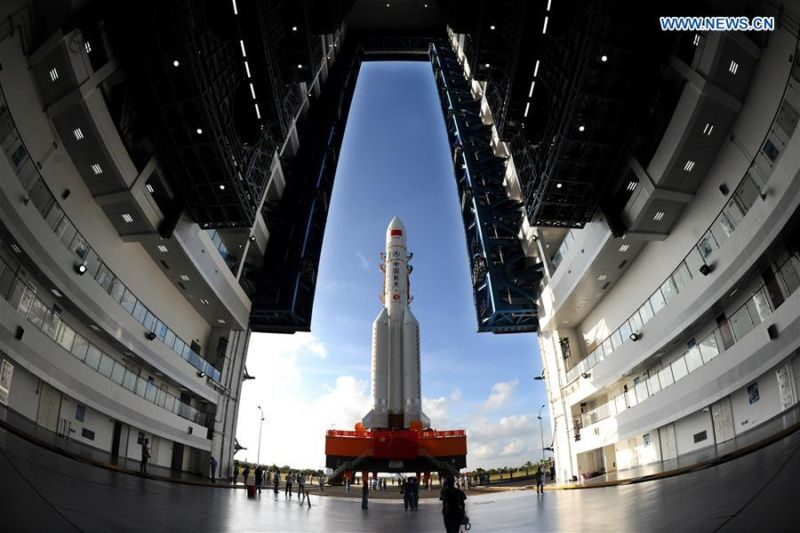
© Xinhua/Sun HaoChina's Long March 5 rocket made its debut in November, 2016.
China appears to be accelerating its plans to land on the Moon by 2030 and would use a modified version of an existing rocket to do so.
The chief designer of the Long March family of rockets, Long Lehao, said China could use two modified Long March 5 rockets to accomplish a lunar landing in less than a decade,
according to the Hong Kong-based online news site, HK01. He spoke earlier this week at the 35th National Youth Science and Technology Innovation Competition in China. The full video can be
found here.
During Lehao's speech, he said
one of these large rockets would launch a lunar lander into orbit around the Moon, and the second would send the crew to meet it. The crew would then transfer to the lander, go down to the Moon's surface, and spend about six hours walking on its surface. Then part of the lunar lander would ascend back to meet the spacecraft and return to Earth.
Lehao's talk does not carry the official imprimatur of Chinese space policy — at least not yet. But he remains an influential figure in Chinese space policy, said Andrew Jones, a journalist who tracks China's space program. "It's a good indication of China working towards that plan to some degree," he told Ars. "There will apparently be an announcement on this rocket at the Zhuhai Airshow in late September or early October."
The Chinese Moon plan would require several technology developments. The Long March 5 rocket, which has a capacity similar to that of a Delta IV Heavy rocket, would be upgraded to become the "Long March 5-DY."
Lehao has previously described these upgrades, which would improve performance for lunar missions. China would also need a lunar lander and a next-generation spacecraft capable of deep space missions.Nevertheless, the use of
an existing rocket that has already launched seven times would simplify the mission for China. Although
the country's aerospace engineers are in the early stages of developing a super-heavy lift rocket named Long March 9, it probably won't be ready for test flights before 2030. By modifying an existing rocket, China could get to the Moon faster.
This only adds further fuel to the idea that NASA and China are in something of a race to the Moon. The United States has created the "Artemis Program" for a lunar return. While this program has a nominal date of a 2024 human landing, that seems infeasible due to the lack of a finished lunar lander, space suits, and other technical problems. The year 2026 seems like the earliest possible date for a lunar landing, and of course that could slip further to the right.
Both countries are also seeking to bring international partners along.
The United States has already added a dozen signatories to the "Artemis Accords," including Australia, Italy, Japan, South Korea, and the United Kingdom. China has reached a deal with Russia to build a lunar research station and is also courting European partners.Former NASA Administrator Mike Griffin, who served under the George W. Bush administration, has long warned US policymakers that China could accelerate its Moon plans and beat NASA by using an existing heavy lift rocket.
Speaking at a 2018 Users Advisory Group meeting of the National Space Council, Griffin said, "They never seem to be in a rush. They seem to be playing the long game. So I'm not saying they will be on the Moon in six to eight years, but if they wanted to be they could. And for them to be back on the Moon when the United States can't get back on the Moon is a travesty."
Now, China be in a rush.
Comment: In their 2019 mission to the dark side of the moon, China has already demonstrated that its space capabilities are world class, and there's reason to believe they may even soon exceed that of the US, which, incidentally has been suffering a number of set backs lately: